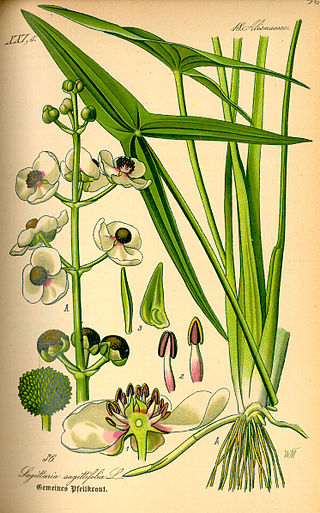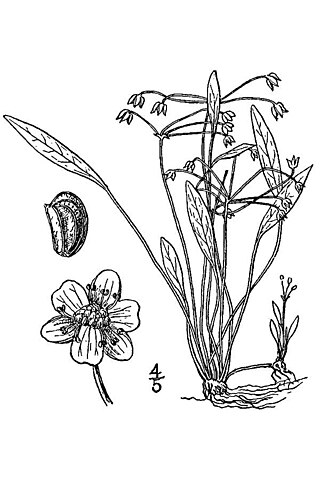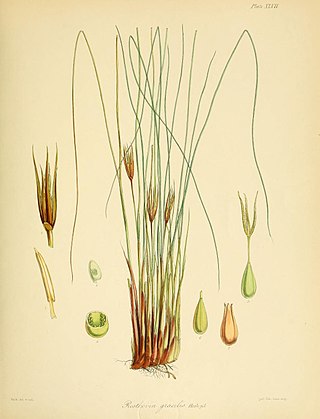
Heinrich Wilhelm Schott was an Austrian botanist. He is known for his extensive work on aroids (Araceae).

Juncus is a genus of monocotyledonous flowering plants, commonly known as rushes. It is the largest genus in the family Juncaceae, containing around 300 species.

The water-plantains (Alismataceae) are a family of flowering plants, comprising 20 genera and 119 species. The family has a cosmopolitan distribution, with the greatest number of species in temperate regions of the Northern Hemisphere. Most of the species are herbaceous aquatic plants growing in marshes and ponds.

Sagittaria is a genus of about 30 species of aquatic plants whose members go by a variety of common names, including arrowhead, duck potato, swamp potato, tule potato, and wapato. Most are native to South, Central, and North America, but there are also some from Europe, Africa, and Asia.

Berthold Carl Seemann was a German botanist. He travelled widely and collected and described plants from the Pacific and South America.

Echinodorus, commonly known as burhead or Amazon sword, is a genus of plants in the family Alismataceae, native to the Western Hemisphere from the central United States to Argentina. Its scientific name is derived from Ancient Greek echius – "rough husk" - and doros – "leathern bottle" - alluding to ovaries, which in some species are armed with persistent styles, forming prickly head of fruit. Some of the species are commonly cultivated in artificial aquatic habitats.

Limnocharitaceae was a family of flowering plants in the monocot order Alismatales. In the APG IV system, it is included in the family Alismataceae. It is commonly known as the water poppy family. Species that have been placed in this taxon are small, perennial, aquatic herbs, native to the tropics, but adventive or naturalized in the subtropics as a result of cultivation.

Strelitzia nicolai, commonly known as the wild banana or giant white bird of paradise, is a species of banana-like plants with erect woody stems reaching a height of 7–8 m (23–26 ft), and the clumps formed can spread as far as 3.5 m (11 ft).

Rostkovia is a genus of flowering plants in the family Juncaceae. It was described in 1809.

Limnophyton is a genus in the family Alismataceae. It includes five species from the Old World tropics. Three species are recognized as of May 2014:

Martin Martens was a Belgian botanist and chemist born in Maastricht, Netherlands.

Najas guadalupensis is a species of aquatic plant known by the common names southern waternymph, guppy grass, najas grass, and common water nymph. It is native to the Americas, where it is widespread. It is considered native to Canada, and most of the contiguous United States, Mexico, Central America, the West Indies and South America. It has been introduced in Japan, and Palestine and Israel.

Daniel Hanbury FRS was a British botanist and pharmacologist. He was an early student of pharmacognosy, the study of the medicinal applications of nature, principally of plants.

Limnocharis flava is a species of aquatic flowering plant which is native to Mexico, Central America, South America, Cuba, Haiti and the Dominican Republic but widely naturalized in southern and southeastern Asia: India, Sri Lanka, Cambodia, Burma, Thailand, Vietnam, Indonesia, Malaysia, Brunei and southern China.
Najas wrightiana is a species of aquatic plant in the Hydrocharitaceae family. It is referred to by the common name Wright's waternymph, and is found in lakes and streams. It is native to Mexico, Guatemala, Belize, Honduras, the Bahamas, Cuba, and Venezuela. It is also considered introduced and naturalized in southern Florida.

Joachim Steetz was a German botanist. His herbarium, comprising more than 5000 specimens from over 160 collectors and 30 countries was purchased in 1863 by Victorian Government Botanist Ferdinand von Mueller for the sum of 80 pounds. The collection is currently housed at the National Herbarium of Victoria. The herbarium was compiled by Steetz over more than thirty years and comprises 160 collectors from more than 30 countries, including type specimens from plant collectors of the time including:

Helanthium tenellum, the pygmy chain sword, is a species of plants in the Alismataceae. It is native to the eastern United States, southern Mexico, West Indies, Central America, South America

Marsippospermum is a genus of flowering plants in the family Juncaceae described in 1809.

Maundia is a genus of alismatid monocots, described in 1858. Maundia was formerly included in the family Juncaginaceae but is now considered to form a family of its own under the name Maundiaceae. It contains only one known species, Maundia triglochinoides, endemic to Australia.
Eremitis is a genus of bamboo plants in the grass family, that is endemic to Brazil.


















